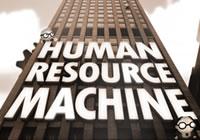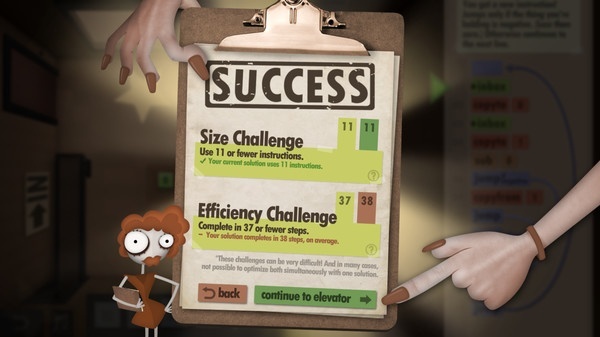Human Resource Machine (PC) Review
By Luna Eriksson  04.12.2015
04.12.2015

Tomorrow Corporation is back once again with the same bleach humour and clever, dark, gameplay that has become its trademark. In Human Resource Machine, the makers of Little Inferno have given players the role of an employee at a company during a new industrial revolution caused by machines that are out to take over every single job available. Due out on Wii U very soon, Cubed3 takes a look at the PC edition first.
Dark, satirical, and clever are all words that can be used to describe the latest title from Tomorrow Corporation. This time all lucky breaks are gone as the protagonist is found at the bottom of a big corporation in the position of sorting boxes, with strings of code helping to make the procedure automatic; very similar, in fact, to how an actual central processing unit (CPU) in a PC works.
The story is simple, yet deep, focusing on industrialisation and how it affects people's lives, putting work into the hands of machines instead, while workers do not even see what is truly going on. This is very cleverly portrayed both in terms of the way the events unfold, as well as the game mechanics. In a similar fashion to how Little Inferno played out, the protagonist is once again slowly-but-surely digging their own grave throughout, and, once again, the impression the story leaves afterwards is strong.

It is dark humour and society-critic satire, taking a hot topic and turning it into a recognisable, dark, and yet not completely uncomfortable, experience that leaves players with both laughter, but also some horrible, disturbing fridge logic to reflect upon afterwards. It is clever story design using the trademark minimalistic tools that fans of Tomorrow Corporation titles have grown fond of.
The gameplay is based on the ways a CPU works, and is very clever and entertaining for anyone that has ever dipped their toes into programming. It could almost be seen as a simple tutorial on how to program CPUs to perform different tasks with most difficult things scaled off for simplification. It is also the perfect tool to use for the gameplay of Human Resource Machine as it is basically the same thing that drives the machines out there.

It is an intriguing way to reveal to people exactly what machines are capable of - giving the opportunity to personally find out how most human tasks can easily be completed without human input…making for quite a disturbing feeling at times. The theme of Human Resource Machine is indeed hard, striking, powerful and smart. While the gameplay mechanics are impressive, there is a massive flaw: the complexity of it all. While Human Resource Machine is a short puzzle title, the conundrums towards the end are some of the most difficult and multi-layered ones found in any games in the genre. That in itself would not be a major issue, yet the difficulty spikes are frustrating.

At the beginning everything is so easy to understand, requiring very little work, yet as progress is made, the complexity grows absurdly quickly, making it hard for many to even figure out what is needed, with advanced mathematical terminology used, forcing players to perform it all in a very clunky system that feels like having a CPU with zero plugins to make the experience easier and less mundane. One thing those in control will get all too familiar with during the latter stages of Human Resource Machine is the horrors of troubleshooting. Even though few solutions are longer than 30 lines of code, it is still shockingly taxing at times to figure out exactly what went wrong, as one faulty line of code can give negative results in a highly unexpected place, something that will come to as a shock to programming newcomers and will likely put too many people off.
It will no doubt be highly loved by its audience and fans of Tomorrow Corporation's other works, yet the sadistic difficulty level presented later on will likely annoy anyone but the most avid programmers or puzzle gamers, leaving the more casual market behind.

Cubed3 Rating
Good
Tomorrow Corporation has presented a clever satire with deep messages incorporated into both the story and gameplay, delivering a unique experience. The imitation of real CPUs is going to be a feature that will make programming enthusiasts crazy and puzzle veterans shake with excitement thanks to the challenge involved. However, due to some almost ridiculous difficulty spikes, Human Resource Machine will most likely not be played through to the end by anyone other than those in said groups, leaving more casual puzzle gamers behind. A smoother difficulty curve would have helped a lot to make this title shine brighter. Other than the steep difficulty, though, this is a memorable experience and a good starting point in learning how to program, starting with the basic code lines, allowing for deep gameplay.

![]() 6/10
6/10
![]() 0
(0 Votes)
0
(0 Votes)
 Out now
Out now  Out now
Out now  None
None  Out now
Out now Comments
Comments are currently disabled

 Sign In
Sign In Game Details
Game Details Subscribe to this topic
Subscribe to this topic Features
Features





 Top
Top

